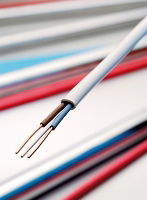With the recent issue of the 17th edition of the IEE Wiring regulation / BS 7671:2008, there has been an upsurge of interest in cables that can be used to meet the requirements of Clause 522.6 on protection from impact.

In particular, clauses 522.6.5 and 522.6.6 refer to cables liable to be damaged by fixings and as one of the possible solutions references cables complying with BS 8436. Although first issued in 2004, BS8436 "e;Electric cables ‐ 300/500V screened electric cables having low emission of smoke and corrosive gases when affected by fire, for use in walls, partitions and building voids ‐ multicore cables"e; is not well known in the marketplace.
The basic issue addressed in these clauses is the possibility of a nail or screw penetrating a cable concealed in a wall or partition and remaining live, thus creating a danger to anyone who may touch it. This is not a new issue and was also addressed by the sixteenth edition, but the new seventeenth edition makes some changes to the requirements and gives more detail.
A number of cable types may be used to ensure compliance with clause 522.6 including armoured cables (BS5467, BS6724, BS7846), MICC cables (BSEN60702-1) and special screened types (BS8436). All of these cable types are suitable because they include an earthable metallic layer. Cables to BS8436 must comply with a nail penetration test specifically developed for this application.
Prymian Earthshield cable is fully compliant with BS8436 and was in fact in use to give protection from nail penetration for some years before BS8436 was issued as a British Standard. It combines a longitudinal aluminium tape screen in contact with a full size CPC (circuit protective conductor) to achieve the necessary earthable layer. It is also a "e;low smoke halogen free"e; product making it suitable all use in all building types.
Other cables are available which have been used for such application for many years and exceed the requirements of BS8436, in particular the nail penetration test. Prysmian Afumex LSX complies with BS8436 except that it is rated at 600/1000V instead of the 300/500V required by the Standard. Because of this, LSX is tested to higher electrical requirements and to a nail penetration test at higher currents than required by BS8436.
